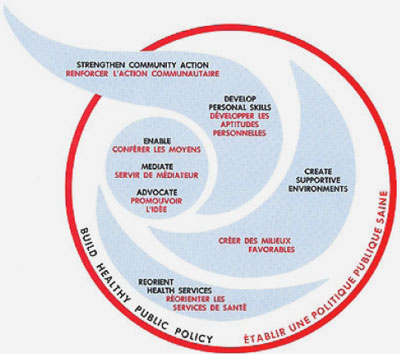
Health promotion: The roots of workplace wellness By Judith Colbert, PhD, Editor, businesshealth
|
Health Promotion logo used by WHO since the Ottawa conference. 1 www.who.int
|
Ideas about health have changed over the years. They have moved from the cure and treatment of disease, to prevention and health promotion. Health promotion, which involves advocacy and action to overcome barriers to health, is the foundation of today’s wellness initiatives. The Ottawa CharterCanada has played a very significant role in establishing the modern framework for health promotion and by extension, workplace wellness. The basis of the framework is the Ottawa Charter for Health Promotion which emerged from the first international conference on the topic in Ottawa in November 19861. Hosted by Health and Welfare Canada, the Canadian Public Health Association and the World Health Organization (WHO), conference delegates worked out a definition that remains current today:
Participation is essential for health promotion. The Charter identifies three basic strategies: advocacy to create conditions for health; enabling to help all people achieve their health potential; and mediating between different social interests in pursuit of health. Levels of actionFrom this perspective, health becomes something to pursue. Responsibility for health is not confined to one domain but has a broad reach and involves much collaboration. The Ottawa Charter identified five nested levels of action necessary to create and maintain health:
Through the years, these levels have been refined to include governments, communities in civil society, and the workplace. When employers offer wellness programs they are, thus, joining with many others to advocate for health. Offering employee education about a specific disease taps into local medical services and non-profit organizations. A fund-raising drive or group run may be part of a community or national initiative. Data from an international organization like WHO is harvested from a world-wide resource. Social determinants of healthIn this issue’s Doctor on Call we learn that obesity is a disease that results from a complex interplay of many factors, including factors in the environment, and is managed by a variety of medical and non-medical strategies. It is a good example of a disease that responds to workplace wellness initiatives that address what are known as the social determinants of health. In keeping with the Ottawa charter, the social determinants include, among others:
Health or wellness?While health and wellness are inevitably linked, there are differences stemming from the action-oriented concept of promotion. Reflecting our changing ideas, WHO’s now widely-accepted definition of health moves away from a focus on disease. Health is, instead, “a state of complete physical, mental and social well-being and not merely the absence of disease or infirmity.” In contrast, wellness is regarded by most, not as a state, but as an active process which involves individual choices and opportunities for change and growth, with improved health as its goal. A health promotion movementWorkplace wellness programs give employees opportunities to act to improve their own health and – by extension – improve the health of their organization. Employers who provide wellness programs are part of a powerful movement to advocate for better health that began over 30 years ago in Ottawa and continues to have broad implications for the health of their community and nation, as well as their own organization and employees. bh |
